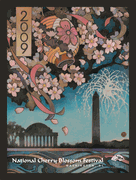By Stuart Hotchkiss
It is officially springtime; even United Airlines says so via e-mail with a “spring is here sale” announcement and a pretty spring image. While most American eyeballs are focused on NCAA “March Madness,” Washingtonians and visitors to the nation’s capital are thinking like United Airlines - pink cherry blossoms.
The National Cherry Blossom Festival (NCBF), a 501(c)(3) organization, annually celebrates the original gift of 3,000 cherry trees from Mayor Yukio Ozaki of Tokyo in 1912 and the enduring friendship between the people of the Unites States and Japan. During the next two weeks, through April 12th, more than 1 million tourists will come to Washington to admire the blossoming cherry trees around the Tidal Basin and attend numerous concerts, competitions, parties and the city’s largest parade (April 4th) that herald the beginning of spring in Washington. First Lady Michelle Obama will serve as Honorary Chair of this year’s festival.
During the next two weeks, through April 12th, more than 1 million tourists will come to Washington to admire the blossoming cherry trees around the Tidal Basin and attend numerous concerts, competitions, parties and the city’s largest parade (April 4th) that herald the beginning of spring in Washington. First Lady Michelle Obama will serve as Honorary Chair of this year’s festival.
Like most festivals, NCBF has evolved into a merchandiser, and the focal point has been its official artwork, created this year by Carol Tomasik of Norton, Ohio. Ms. Tomasik’s original colored pencil drawing has been reproduced as a beautiful poster and adapted for t-shirt, sweatshirt, coffee mug and other product designs.
Collectors delight every year when the new NCBF lapel pin is released, and the fact that the year is tastefully etched into the back side of each pin shows that the organization has carefully thought about its “look.” 
The festival’s website has been the primary source of distribution for merchandise and this year’s site has a new boutique section, indicative of the NCBF’s increasing brand value and the growing demand from its loyal supporters for artisan jewelry and other fine craftwork.
A particularly stunning piece in the boutique is a handscultpted stoneware clay cherry blossom pendant – adorned with fresh water pearls linked together by 14k gold-filled wire – and attached to a freshwater pearl necklace. Earrings and pins handsculpted in the same manner as the pendant are also available. With the support of the DC Chamber of Commerce, the NCBF has created a new retail venue in the city’s Visitor Information Center, located inside the Ronald Regan Building and International Trade Center at 1300 Pennsylvania Avenue NW (one block from the White House Visitor Center).
With the support of the DC Chamber of Commerce, the NCBF has created a new retail venue in the city’s Visitor Information Center, located inside the Ronald Regan Building and International Trade Center at 1300 Pennsylvania Avenue NW (one block from the White House Visitor Center).
“The city of Washington has always supported our festival needs, and the added cooperation we’ve received from the Chamber has been a boost to our long-term strategic plans,” says NCBF President Diana Mayhew. “We have worked with local artists and suppliers to create an exclusive array of festival merchandise that is both tasteful and we can call our own.”
The NCBF merchandise should be a breath of fresh air for souvenir shoppers in Washington; for at least four months, Obama merchandise sourced overseas has been distributed on a non-exclusive basis throughout hundreds of street and store vendors in the city and its environs. Those who are in town to see the cherry blossoms now have good reason to ignore it.
Stuart Hotchkiss is the owner of Capital Ties, a privately owned neckwear design and manufacturing business in Washington, DC. Prior to his life as an entrepreneur, Stuart served as President of Time Inc. Home Entertainment, a $200 million enterprise of mail order, retail and licensing businesses, all brand extensions of the Time Inc. Magazine Group. Stuart also was in charge of Time Inc.’s in-house advertising agency.















 But Charlie didn't start working for Crane until 1950 when he got out of the Navy, so I knew it had to be his Dad. Sure enough it was. Charlie tells me that he and his father used to make paper together at Crane's Old Berkshire Mill. Charlie the elder was the machine tender, aka the boss, and Charlie the younger was the backtender, aka the underling. Of course that's how it should be and how it's been done here for more than 200 years - passing down traditions and expertise from generation to generation. Charlie says his father was a tough boss, but "he could make that machine work when no one else could."
But Charlie didn't start working for Crane until 1950 when he got out of the Navy, so I knew it had to be his Dad. Sure enough it was. Charlie tells me that he and his father used to make paper together at Crane's Old Berkshire Mill. Charlie the elder was the machine tender, aka the boss, and Charlie the younger was the backtender, aka the underling. Of course that's how it should be and how it's been done here for more than 200 years - passing down traditions and expertise from generation to generation. Charlie says his father was a tough boss, but "he could make that machine work when no one else could." It was a surprise to me that the paper was not made from cotton or flax, but hemp.
It was a surprise to me that the paper was not made from cotton or flax, but hemp.




